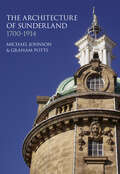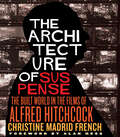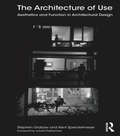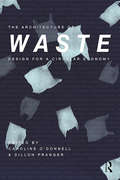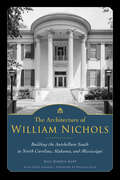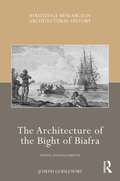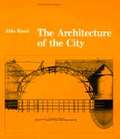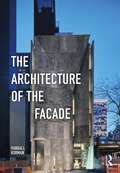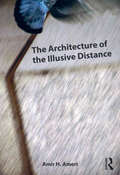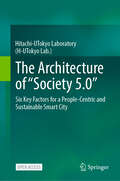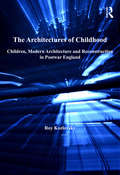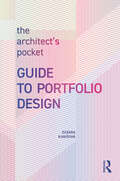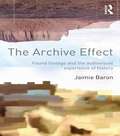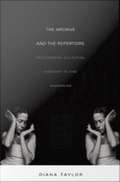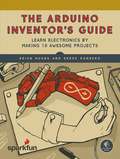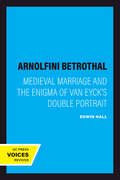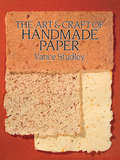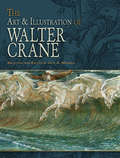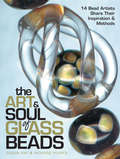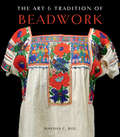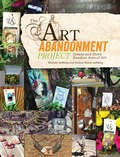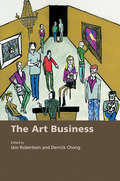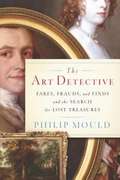- Table View
- List View
The Architecture of Sunderland: 1700-1914
by Michael Johnson Graham PottsSunderland is largely a product of the eighteenth and nineteenth centuries, when coalmining and shipbuilding fuelled rapid expansion and development. Once known as the ‘largest shipbuilding town in the world’, Sunderland’s proud and distinctive identity is embodied in its historic buildings and in its changing urban form. The Architecture of Sunderland, 1700-1914 examines the city’s architectural history during the highpoint of its growth and prosperity. Exploring the cityscape from the richest to the humblest buildings, it brings to life the economic, social and cultural forces that have shaped the city. The text is illustrated with fascinating archival images and photographs taken especially for this volume.
The Architecture of Suspense: The Built World in the Films of Alfred Hitchcock (Midcentury)
by Christine Madrid FrenchThe inimitable, haunting films of Alfred Hitchcock took place in settings, both exterior and interior, that deeply impacted our experiences of his most unforgettable works. From the enclosed spaces of Rope and Rear Window to the wide-open expanses of North by Northwest, the physical worlds inhabited by desperate characters are a crucial element in our perception of the Hitchcockian universe. As Christine Madrid French reveals in this original and indispensable book, Hitchcock’s relation to the built world was informed by an intense engagement with location and architectural form—in an era marked by modernism’s advance—fueled by some of the most creative midcentury designers in film.Hitchcock saw elements of the built world not just as scenic devices but as interactive areas to frame narrative exchanges. In his films, building forms also serve a sentient purpose—to capture and convey feelings, sensations, and moments that generate an emotive response from the viewer. Visualizing the contemporary built landscape allowed the director to illuminate Americans’ everyday experiences as well as their own uncertain relationship with their environment and with each other.French shares several untold stories, such as the real-life suicide outside the Hotel Empire in Vertigo (which foreshadowed uncannily that film’s tragic finale), and takes us to the actual buildings that served as the inspiration for Psycho’s infamous Bates Motel. Her analysis of North by Northwest uncovers the Frank Lloyd Wright underpinnings for Robert Boyle’s design of the modernist house from the film’s celebrated Mount Rushmore sequence and ingeniously establishes the Vandamm House as the prototype of the cinematic trope of the villain’s lair. She also shows how the widespread unemployment of the 1930s resulted in a surge of gifted architects transplanting their careers into the film industry. These practitioners created sets that drew from contemporary design schools of thought and referenced real structures, both modern and historic. The Architecture of Suspense is the first book to document how these great architectural minds found expression in Hitchcock’s films and how the director used their talents and his own unique vision to create an enduring and evocative cinematic world.Publication of this volume was assisted by a grant from Furthermore: a program of the J. M. Kaplan Fund
The Architecture of Use: Aesthetics and Function in Architectural Design
by Stephen Grabow Kent SpreckelmeyerBy analyzing ten examples of buildings that embody the human experience at an extraordinary level, this book clarifies the central importance of the role of function in architecture as a generative force in determining built form. Using familiar twentieth-century buildings as case studies, the authors present these from a new perspective, based on their functional design concepts. Here Grabow and Spreckelmeyer expand the definition of human use to that of an art form by re-evaluating these buildings from an aesthetic and ecological view of function. Each building is described from the point of view of a major functional concept or idea of human use which then spreads out and influences the spatial organization, built form and structure. In doing so each building is presented as an exemplar that reaches beyond the pragmatic concerns of a narrow program and demonstrates how functional concepts can inspire great design, evoke archetypal human experience and help us to understand how architecture embodies the deeper purposes and meanings of everyday life.
The Architecture of Waste: Design for a Circular Economy
by Caroline O’DonnellGlobal material crises are imminent. In the very near future, recycling will no longer be a choice made by those concerned about the environment, but a necessity for all. This means a paradigm shift in domestic behavior, manufacturing, construction, and design is inevitable. The Architecture of Waste provides a hopeful outlook through examining current recycling practices, rethinking initial manufacturing techniques, and proposing design solutions for second lives of material-objects. The book touches on a variety of inescapable issues beyond our global waste crisis including cultural psyches, politics, economics, manufacturing, marketing, and material science. A series of crucial perspectives from experts cover these topics and frames the research by providing a past, present, and future look at how we got here and where we go next: the historical, the material, and the design. Twelve design proposals look beyond the simple application of recycled and waste materials in architecture—an admirable endeavor but one that does not engage the urgent reality of a circular economy—by aiming to transform familiar, yet flawed, material-objects into closed-loop resources. Complete with over 150 color images and written for both professionals and students, The Architecture of Waste is a necessary reference for rethinking the traditional role of the architect and challenging the discipline to address urgent material issues within the larger design process.
The Architecture of William Nichols: Building the Antebellum South in North Carolina, Alabama, and Mississippi
by Paul Hardin KappThe Architecture of William Nichols: Building the Antebellum South in North Carolina, Alabama, and Mississippi is the first comprehensive biography and monograph of a significant yet overlooked architect in the American South. William Nichols designed three major university campuses—the University of North Carolina, the University of Alabama, and the University of Mississippi. He also designed the first state capitols of North Carolina, Alabama, and Mississippi. Nichols's architecture profoundly influenced the built landscape of the South but due to fire, neglect, and demolition, much of his work was lost and history has nearly forgotten his tremendous legacy. In his research onsite and through archives in North Carolina, Alabama, Louisiana, and Mississippi, Paul Hardin Kapp has produced a narrative of the life and times of William Nichols that weaves together the elegant work of this architect with the aspirations and challenges of the Antebellum South. It is richly illustrated with over two hundred archival photographs and drawings from the Historic American Building Survey.
The Architecture of the Bight of Biafra: Spatial Entanglements (Routledge Research in Architectural History)
by Joseph GodlewskiThe Architecture of the Bight of Biafra challenges linear assumptions about agency, progress, and domination in colonial and postcolonial cities, adding an important sub‑Saharan case study to existing scholarship on globalization and modernity.Intersected by small creeks, rivulets, and dotted with mangrove swamps, the Bight of Biafra has a long history of decentralized political arrangements and intricate trading networks predating the emergence of the Atlantic world. While indigenous merchants in the region were active participants in the transatlantic slave trading system, they creatively resisted European settlement and maintained indigenous sovereignty until the middle of the nineteenth century. Since few built artifacts still exist, this study draws from a close reading of written sources—travelers’ accounts, slave traders’ diaries, missionary memoirs, colonial records, and oral histories—as well as contemporary fieldwork to trace transformations in the region’s built environment from the sixteenth century to today. With each chapter focusing on a particular spatial paradigm in this dynamic process, this book uncovers the manifold and inventive ways in which actors strategically adapted the built environment to adjust to changing cultural and economic circumstances. In parallel, it highlights the ways that these spaces were rhetorically constructed and exploited by foreign observers and local agents. Enmeshed in the history of slavery, colonialism, and the modern construction of race, the spatial dynamics of the Biafran region have not been geographically delimited. The central thesis of this volume is that these spaces of entanglement have been productive sites of Black identity formation involving competing and overlapping interests, occupying multiple positions and temporalities, and ensnaring real, imagined, and sometimes contradictory aims.This book will be of interest to researchers and students of architecture, architectural history, urban geography, African studies, and Atlantic studies.
The Architecture of the City
by Aldo Rossi Diane Ghirardo Peter Eisenman Joan OckmanAldo Rossi, a practicing architect and leader of the Italian architectural movement La Tendenza, is also one of the most influential theorists writing today. The Architecture of the City is his major work of architectural and urban theory. In part a protest against functionalism and the Modern Movement, in part an attempt to restore the craft of architecture to its position as the only valid object of architectural study, and in part an analysis of the rules and forms of the city's construction, the book has become immensely popular among architects and design students. An Oppositions Book.
The Architecture of the Facade
by Randall KormanThe Architecture of the Facade provides a comprehensive study of the facade as both a physical and cultural artifact, highlighting its significance as a critical component of the civic realm and arguing for the restoration of the art of the facade as both a subject of study within academia and an aspiration within the profession at large. As the principal surface of mediation, contextualization, and representation, the facade carries the lion’s share of responsibility for containing the internal environment and confronting the outer world. And yet, in recent decades, the very question of what exactly a facade is has been raised by the dramatic changes in building technology, advances of parametric design, and the ubiquity of autonomous buildings. The Architecture of the Facade addresses these and other related issues. The book is organized into 12 chapters, with each chapter focusing on a particular aspect of the phenomenon of the facade such as those of wall, the frame, transparency, and the role of the facade in civic space. Korman also discusses proportional systems, the language of composition, the role of precedent, the importance of context, and much more. Over 350 photos and diagrams provide readers with a variety of examples of artful facades throughout history. Online teaching resources that accompany this book include a course syllabus, a glossary, and a Pinterest tack board of facades. This book will be of great interest to students in architecture studios as well as instructors and professional architects interested in facade design.
The Architecture of the Illusive Distance
by Amir H. AmeriFocusing on three secular institutional building types: libraries, museums, and cinemas, this book explores the intricate interplay between culture and architecture. It explores the cultural imperatives which have seen to the formation of these institutions, the development of their architecture, and their transformation over time. The relationship between culture and architecture is often perceived as a monologic relationship. Architecture is seen to embody, represent and/or reflect the values, the beliefs, and the aesthetic ideals of a culture. Ameri argues that this is at best a partial and restrictive view, and that if architecture is a cultural statement, it is a performative one. It does not merely represent culture, but constructs, reifies, and imposes culture as the unalterable shape of reality. Whereas the concept and the study of cultural performatives have had an important critical impact on the humanities, architecture as a cultural performative has not received the necessary scholarly attention and, in part, this book aims to fill this gap. Whereas building-type studies have been largely restricted to elucidating how best to design building-types based on historic and contemporary precedents, studies in the humanities that analytically and critically engage the secular institutions and their history as cultural performatives, typically cast a blind or perfunctory glance at the performative complicity of their architecture. This book aims to address the omissions in both these approaches. The library, the museum, and the movie-theater have been selected for close critical study because, this book argues, each has been instituted to house, ’domesticate,’ and restrain a specific form of representation. The aim has been to protect and promulgate the metaphysics of presence as Jacques Derrida expounds the concept. This book proposes that it is against the dangers of unconstrained cohabitation of reality and representation that the library, the m
The Architecture of the Roman Triumph
by Maggie L. PopkinThis book offers the first critical study of the architecture of the Roman triumph, ancient Rome's most important victory ritual. Through case studies ranging from the republican to imperial periods, it demonstrates how powerfully monuments shaped how Romans performed, experienced, and remembered triumphs and, consequently, how Romans conceived of an urban identity for their city. Monuments highlighted Roman conquests of foreign peoples, enabled Romans to envision future triumphs, made triumphs more memorable through emotional arousal of spectators, and even generated distorted memories of triumphs that might never have occurred. This book illustrates the far-reaching impact of the architecture of the triumph on how Romans thought about this ritual and, ultimately, their own place within the Mediterranean world. In doing so, it offers a new model for historicizing the interrelations between monuments, individual and shared memory, and collective identities.
The Architecture of “Society 5.0”: Six Key Factors for a People-Centric and Sustainable Smart City
by Hitachi-UTokyo LaboratoryThis open access book introduces H-UTokyo Lab’s ideas about the architecture for Society 5.0, including the process and organizational infrastructure for building smart cities that embody the Society 5.0 vision. It introduces six factors critical to the success of efforts to build people-centric sustainable smart cities. Each factor represents something needed to enable a local government to build a smart city, address the local issues, and ensure that these efforts contribute toward a people-centric sustainable society. The book is not only focused on initiatives that use digital innovation but extends beyond technological aspects, it also emphasizes the overall architecture—the general structures and organizational designs that encompass digital initiatives among other things. Through this book, readers get a better understanding of the current status of the smart-city agenda and its future path. The book is designed to serve as a handbook for public officials in national and local government, for businesspeople, for academics, for those in the third sector, and for any other actor involved in this undertaking.
The Architectures of Childhood: Children, Modern Architecture and Reconstruction in Postwar England (Ashgate Studies in Architecture)
by Roy KozlovskyBetween 1935 and 1959, the architecture of childhood was at the centre of architectural discourse in a way that is unique in architectural history. Some of the seminal projects of the period, such as the Secondary Modern School at Hunstanton by Peter and Alison Smithson, Le Corbusier’s Unité d’Habitation at Marseilles, or Aldo van Eyck’s playgrounds and orphanage, were designed for children; At CIAM, architects utilized photographs of children to present their visions for reconstruction. The unprecedented visibility of the child to architectural discourse during the period of reconstruction is the starting point for this interdisciplinary study of modern architecture under welfare state patronage. Focusing mainly on England, this book examines a series of innovative buildings and environments developed for children, such as the adventure playground, the Hertfordshire school, the reformed children hospital, Brutalist housing estates, and New Towns. It studies the methods employed by architects, child experts and policy makers to survey, assess and administer the physiological, emotional and developmental needs of the ’user’, the child. It identifies the new aesthetic and spatial order permeating the environments of childhood, based on endowing children with the agency and autonomy to create a self-regulating social order out of their own free will, while rendering their interiority and sociability observable and governable. By inserting the architectural object within a broader social and political context, The Architectures of Childhood situates post-war architecture within the welfare state’s project of governing the self, which most intensively targeted the citizen in the making, the children. Yet the emphasis on the utilization of architecture as an instrument of power does not reduce it into a mere document of social policy, as the author uncovers the surplus of meaning and richness of experience invested in these environments at the historical mom
The Architect’s Pocket Guide to Portfolio Design
by Zuzana KubišováThis is an essential guide for architecture and design students struggling to put together an effective portfolio.There is too often a haphazard approach to architecture portfolio design and creation. Without a fundamental understanding of basic graphic design principles, portfolios can seem garish and disjointed, doing a disservice to the work on show and the designers’ professional potential. This concise and highly visual guide explains the fundamental principles of portfolio creation, provides dos and don’ts, common mistakes, and analysis of a diverse range of both successful and unsuccessful samples. Aspirational, innovative design work is also presented alongside detailed commentary breaking down the reasons why it works. Chapters walk through the complete process in an intuitive way, covering purpose, curation, form, layout, content and review, while providing both digital and print techniques.Following the framework laid out in this book will quickly and effectively elevate any architecture portfolio, allowing you to showcase your work in the most professional way possible.
The Archive Effect: Found Footage and the Audiovisual Experience of History
by Jaimie BaronThe Archive Effect: Found Footage and the Audiovisual Experience of History examines the problems of representation inherent in the appropriation of archival film and video footage for historical purposes. Baron analyses the way in which the meanings of archival documents are modified when they are placed in new texts and contexts, constructing the viewer’s experience of and relationship to the past they portray. Rethinking the notion of the archival document in terms of its reception and the spectatorial experiences it generates, she explores the ‘archive effect’ as it is produced across the genres of documentary, mockumentary, experimental, and fiction films. This engaging work discusses how, for better or for worse, the archive effect is mobilized to create new histories, alternative histories, and misreadings of history.The book covers a multitude of contemporary cultural artefacts including fiction films like Zelig, Forrest Gump and JFK, mockumentaries such as The Blair Witch Project and Forgotten Silver, documentaries like Standard Operating Procedure and Grizzly Man, and videogames like Call of Duty: World at War. In addition, she examines the works of many experimental filmmakers including those of Péter Forgács, Adele Horne, Bill Morrison, Cheryl Dunye, and Natalie Bookchin.
The Archive and the Repertoire: Performing Cultural Memory in the Americas
by Diana TaylorIn The Archive and the Repertoire preeminent performance studies scholar Diana Taylor provides a new understanding of the vital role of performance in the Americas. From plays to official events to grassroots protests, performance, she argues, must be taken seriously as a means of storing and transmitting knowledge. Taylor reveals how the repertoire of embodied memory--conveyed in gestures, the spoken word, movement, dance, song, and other performances--offers alternative perspectives to those derived from the written archive and is particularly useful to a reconsideration of historical processes of transnational contact. The Archive and the Repertoire invites a remapping of the Americas based on traditions of embodied practice. Examining various genres of performance including demonstrations by the children of the disappeared in Argentina, the Peruvian theatre group Yuyachkani, and televised astrological readings by Univision personality Walter Mercado, Taylor explores how the archive and the repertoire work together to make political claims, transmit traumatic memory, and forge a new sense of cultural identity. Through her consideration of performances such as Coco Fusco and Guillermo Gmez-Pea's show Two Undiscovered Amerindians Visit . . . , Taylor illuminates how scenarios of discovery and conquest haunt the Americas, trapping even those who attempt to dismantle them. Meditating on events like those of September 11, 2001 and media representations of them, she examines both the crucial role of performance in contemporary culture and her own role as witness to and participant in hemispheric dramas. The Archive and the Repertoire is a compelling demonstration of the many ways that the study of performance enables a deeper understanding of the past and present, of ourselves and others.
The Arduino Inventor's Guide: Learn Electronics by Making 10 Awesome Projects
by Derek Runberg Brian HuangWith Arduino, you can build any hardware project you can imagine. This open-source platform is designed to help total beginners explore electronics, and with its easy-to-learn programming language, you can collect data about the world around you to make something truly interactive.The Arduino Inventor's Guide opens with an electronics primer filled with essential background knowledge for your DIY journey. From there, you’ll learn your way around the Arduino through a classic hardware entry point—blinking LEDs. Over the course of the book, 11 hands-on projects will teach you how to:–Build a stop light with LEDs–Display the volume in a room on a warning dial–Design and build a desktop fan–Create a robot that draws with a motor and pens–Create a servo-controlled balance beam–Build your own playable mini piano–Make a drag race timer to race toy cars against your friendsEach project focuses on a new set of skills, including breadboarding circuits; reading digital and analog inputs; reading magnetic, temperature, and other sensors; controlling servos and motors; and talking to your computer and the Web with an Arduino. At the end of every project, you’ll also find tips on how to use it and how to mod it with additional hardware or code.What are you waiting for? Start making, and learn the skills you need to own your technology!Uses the Arduino Uno board or SparkFun RedBoard
The Arnolfini Betrothal: Medieval Marriage and the Enigma of Van Eyck's Double Portrait (The Discovery Series #3)
by Edwin HallThis title is part of UC Press's Voices Revived program, which commemorates University of California Press’s mission to seek out and cultivate the brightest minds and give them voice, reach, and impact. Drawing on a backlist dating to 1893, Voices Revived makes high-quality, peer-reviewed scholarship accessible once again using print-on-demand technology. This title was originally published in 1994.This title is part of UC Press's Voices Revived program, which commemorates University of California Press’s mission to seek out and cultivate the brightest minds and give them voice, reach, and impact. Drawing on a backlist dating to 1893, Voices Revived</DIV
The Art & Craft of Handmade Paper
by Vance StudleyIf you can chop vegetables and boil water, you can make paper. It's easy with this fascinating step-by-step guide to making paper with vegetable fibers. No special tools are required and quality results can be had in a very short time.The opening chapter of Vance Studley's clearly outlined, beautifully illustrated text introduces the reader to the origin and development of paper, describes its use in history, examines cultures that made paper and explains why quality paper is ideal for creative use.The author then shows you in detail how to make attractive and useful paper in a vast number of sizes, shapes, textures, and colors. Details of the papermaking process range from scissoring the raw material and beating the pulp, to blending the contents and forming, pressing, drying, and separating the sheets.Step-by-step instructions and over 160 sharply detailed illustrations introduce professional artists as well as students of all ages and levels of expertise to necessary materials, tools, and equipment. A final chapter suggests a variety of projects, including the compilation of a portfolio, creating papers for printmaking and drawing, and producing a collage from the designer's finished product.An invaluable book for the craftsperson interested in learning a satisfying and fascinating hobby, this comprehensive manual will also appeal to artists in search of distinctive papers and teachers looking for a refreshing change in classroom projects.
The Art & Illustration of Walter Crane (Dover Fine Art, History of Art)
by Jeff A. Menges Walter CraneA prominent figure in the Victorian art world, Walter Crane not only participated in the late nineteenth century's publishing revolution but also led the way toward the Golden Age of Illustration. Crane was instrumental in the transition from simple black-and-white illustrations for children's books to gallery-quality artwork. This original collection features more than one hundred of the influential artist's brilliant images. It constitutes a survey of his paintings as well as a visual history of the development of the first color illustrations.Few artists of Crane's generation achieved careers as varied and successful as his. This compilation reflects the diversity of his subjects, from images for alphabet books, nursery rhymes, and fairy tales to scenes from stories of King Arthur and Robin Hood to illustrations inspired by the classics of Shakespeare, Hawthorne, and Spenser. Editor Jeff A. Menges provides an Introduction that places the artist and his works in historic context.
The Art & Soul of Glass Beads: 17 Bead Artists Share Their Inspiration & Methods
by Richard Pearce Susan RayAt last, a book that explores the origins and renaissance of lampwork glass beads and offers a one-on-one journey with fourteen exceptional glass bead artists as they create more than 20 projects. Step-by-step instruction and beautiful photography shows crafters how to create stunning necklaces, earrings, bracelets, and much more. This new reference gives an inside look at the artists' creative processes, including how they choose color and materials and how they add the finishing touches. Most importantly, they reveal how serendipity plays a role in their creative processes. Readers will be inspired to embark on an artistic journey to create magnificent works of art for future generations to behold.
The Art & Tradition of Beadwork
by Marsha C. BolA former professor and museum director offers a fascinating, in-depth look at the culture and history of beaded objects around the world. From a beaded dress found in an ancient Egyptian tomb to the beaded fringe on a 1920s Parisian flapper&’s hem, humans throughout history have used beading as a way to express, adorn, and tell a story. Bol explores beadwork across the world and through the ages, showing how beading has taken on many different styles, forms, and purposes for different cultures. She looks at children&’s clothing, puberty ceremonies, burials, emblems of social status and leadership, festivals, and many other cultural occasions that involve the use of beadwork. Images of artifacts and heirlooms as well as photography of people and their beadwork enhance the scholarship of this book for a beautiful, enlightening addition to art, history, multicultural collections everywhere.
The Art Abandonment Project: Create and Share Random Acts of Art
by Michael Demeng Andrea Matus DemengArt sharing at its sneakiest!Art sharing at its sneakiest! The Art Abandonment Project is your guide to expressing yourself through random acts of art! Create something for the joy of making it, and then leave it for an unsuspecting person to find--be it on a shelf at the library, a park bench, a table at a coffee shop or anywhere a stranger might stumble upon it. Inside you'll discover fun ideas for monthly abandonment challenges, way to connect with other "abandoneers" in the creative community, the value of sharing with others and more. Learn the ins and outs of being an abandoneer. Get ideas and inspiration for monthly abandoning challenges. See examples of abandoned art, and read the stories of the artists as well as the "finders." Receive helpful encouragement for letting go of your creations (sometimes it's hard!). Connect with the Art Abandonment community and learn how to share your own stories with others. Join the art abandonment project, set your art fee and make someone's day!
The Art Business: Inside The World Of Art And Business (Handbook In International Art Business Ser.)
by Iain RobertsonBy the time you read this book, the art world may have witnessed the sale of its first $500 million painting. Whilst for some people money is anathema to art this is clearly a wealthy international industry, and a market with its own conventions and pressures. Drawing on the vast experience of Sotheby’s Institute of Art, The Art Business exposes the realities of the commercial trade in fine art and antiques. Attention is devoted to the role of auction houses, commercial galleries and art museums as key institutions, with the text divided into four thematic sections covering: technical and structural elements of the art market cultural policy and management in art business regulatory legal and ethical issues in the art world the views, through interviews, of leading art market experts. This book provides a thorough examination of contemporary issues in the art business, and the mechanisms and influences which underpin its evolution. It is essential reading for students of art history or international business, or anyone with an interest in pursuing a career in this area.
The Art Collector in Early Modern Italy: Andrea Odoni and his Venetian Palace
by Monika SchmitterLorenzo Lotto's Portrait of Andrea Odoni is one of the most famous paintings of the Italian Renaissance. Son of an immigrant and a member of the non-noble citizen class, Odoni understood how the power of art could make a name for himself and his family in his adopted homeland. Far from emulating Venetian patricians, however, he set himself apart through the works he collected and the way he displayed them. In this book, Monika Schmitter imaginatively reconstructs Odoni's house – essentially a 'portrait' of Odoni through his surroundings and possessions. Schmitter's detailed analysis of Odoni's life and portrait reveals how sixteenth-century individuals drew on contemporary ideas about spirituality, history, and science to forge their own theories about the power of things and the agency of object. She shows how Lotto's painting served as a meta-commentary on the practice of collecting and on the ability of material things to transform the self.
The Art Detective
by Philip MouldThe supremely telegenic star of the original Antiques Roadshow dishes up his best tales of uncovering lost masterpieces and unmasking fakes. How can you tell a masterpiece from a piece of junk? Philip Mould has been so successful at discovering buried treasures that he's affectionately known as "the art detective. " Now, at last, he has decided to let the eleven million fans of Antiques Roadshow in on his secrets. Each chapter revolves around a particular painting and the people who helped unmask its creator's identity-from an ingeniously forged Norman Rockwell (good enough to fool the Rockwell Museum) to a Winslow Homer found in a dump. Witty and compulsively readable, The Art Detective is memoir, art history, and brilliant storytelling all rolled into one. .
